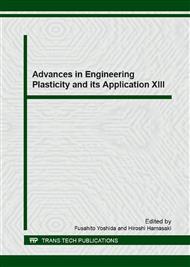p.3
p.15
p.33
p.41
p.47
p.55
p.60
p.66
p.72
Plastic Limit Analysis of Piping with Local Wall-Thinning under Elevated Temperature
Abstract:
In order to evaluate the safety and integrity of piping with local wall-thinning at elevated temperature, a numerical method for plastic limit load of modified 9Cr-1Mo steel piping is proposed in the present paper. The limit load of piping at high temperature is defined as the load-carrying capacity after the structure has served for a certain time period. The power law creep behavior with Liu-Murakami damage model is implemented into the commercial software ABAQUS via CREEP for simulation, and the Ramberg-Osgood model is modified to consider the material deterioration effect of modified 9Cr-1Mo steel by introducing the creep damage factor into the elasto-plastic constitutive equation. For covering the wide ranges of defect ratios and service time periods, various 3-D numerical examples for the piping with local wall-thinning defects, and creep time are calculated and analyzed. The limit loads of the defected structures under high temperature are obtained through classic zero curvature criterion with the modified Ramberg-Osgood model, and the typical failure modes of these piping are also discussed. The results show that the plastic limit load of piping containing defect at elevated temperature depends not only on the size of defect, but also on the creep time, which is different from the traditional plastic limit analysis at room temperature without material deterioration.
Info:
Periodical:
Pages:
47-52
Citation:
Online since:
December 2016
Authors:
Price:
Сopyright:
© 2017 Trans Tech Publications Ltd. All Rights Reserved
Share:
Citation:


